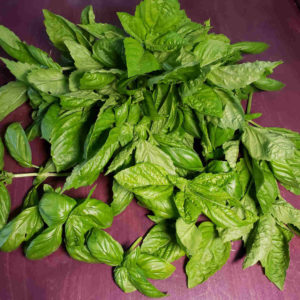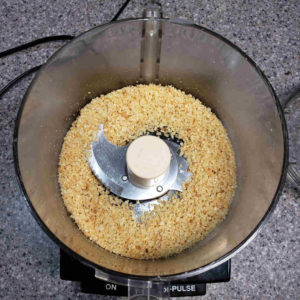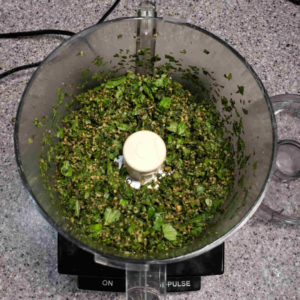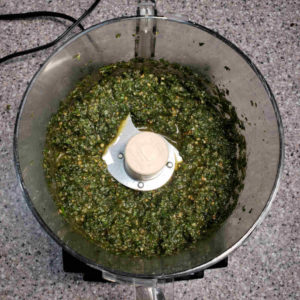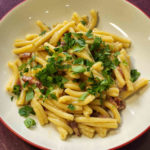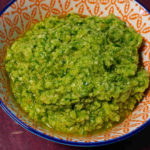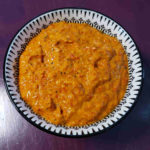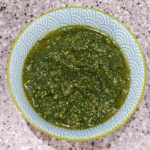The recipe below is for a classic pesto, but you should know that the variations are practically limitless. Where basil is the herb used in classic pesto, you can use different herbs, or even things that aren’t traditionally considered herbs, such as garlic scapes, stinging nettles, sweet red peppers, arugula and carrot tops. When I use alternate herbs, I usually name the pesto by the alternate herb, such as Arugula Pesto. I sometimes even say Basil Pesto, which may sound redundant, but I make pestos in so many different ways, it seems like the right thing to do. Besides the herbs, you can also swap the nuts and cheese. Pine nuts are wonderful, but they are very expensive. I often swap them for pecans or pistachios. For a more earthy presentation, I may use walnuts; for a more decadent presentation, hazelnuts. And the cheese… I like to use Calvander from the Chapel Hill Creamery, because it is local and really good. It’s made in the style of aged asiago. Pecorino Romano is an obvious alternative to Parmesan, but if you have other aged, hard cheeses that you like, give them a try.
To Blanch or Not to Blanch
Some pesto recipes will have you blanch the basil before adding it to the food processor. The reason for the blanching is to lock in the bright green color of the fresh basil. I can tell you that it works, but at a price. Using blanched basil will indeed produce a bright green pesto. It will also produce a pesto with a smoother texture. But the flavor will suffer. One of the things that makes basil so special is the aromatic molecules that are released just by touching it. The fragrance in the kitchen as you pull basil leaves from the stems is one of the most amazing sensations of summertime. Blanching destroys that aspect of basil. Blanched basil pesto will still taste great, but not as good as non-blanched. And for me, the tradeoff is not worth it. Dark green pesto still looks pretty good!
How Much Basil?
The short answer is A LOT. Basil is hard to measure. You can count leaves, but the leaf size varies greatly between varieties of basil, and they vary greatly even on the same plant. In the recipe, I say 4 cups of loosely packed basil leaves. But, how packed is loosely packed? The photo shows how much basil I use to get 4 cups of loosely packed leaves. Weighing the basil leaves, by the gram, is going to be the most accurate measurement, but it’s not that practical. Truth be told, I generally don’t bother with measuring when I make pesto. I eyeball what I think is about 2 ounces, by weight, of cheese and chop it into small chunks. I take a few cloves of garlic and give a rough chop. I then toss them into the blender along with a small handful of nuts & pulse until the nuts and cheese are ground fairly finely. I then add a whole bunch of herbs and a pinch of salt and pulse a few times. Then I add a glug of olive oil and pulse. Taste… Add more salt if necessary. Add more olive oil if I want a looser feel to the pesto.
Does Pesto Store Well?
Yes! First, it freezes well. Second, it lasts quite a while in the fridge if you take some care. When I make a batch of pesto, I get a couple cups. I divide that up between some 4 to 8 ounce mason jars. I carefully tamp the pesto down so the surface is smooth. I then pour a thin film of olive oil over the top and throw them all in the fridge. As the olive oil cools, it will congeal and provide a protective barrier to the pesto underneath. I then move all but one jar into the freezer the next morning. After using some portion of the refrigerated pesto, I use a clean spoon to retamp to a smooth surface and reapply a thin film of olive oil. I’ve kept pesto in the fridge for as long as a month this way.
What Do You Do with Pesto?
So many things. Pestos are truly secret sauces. Pesto is definitely my favorite pizza sauce. When I make tomato plates, they always get dressed with a dab of pesto and some goat cheese. Tossing grilled vegetables in a little pesto is a nice finishing touch. Imagine spreading some pesto on the inside of a grilled cheese sandwich! Or spreading on a thick slice of toast and covering that toast with custardy scrambled eggs! So many options with pastas. So many options with soups. Make your pesto and enjoy it!
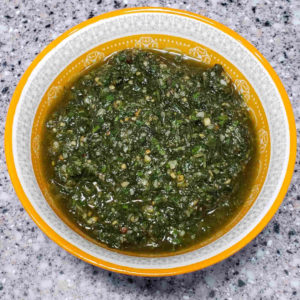
Classic Pesto
Equipment
- Food processor.
Ingredients
- 4 cups loosely packed basil leaves
- ¼ cup pine nuts
- 2 ounces Parmigiano Reggiano by weight
- 2 cloves garlic
- ½ cup extra virgin olive oil
- 1 tsp salt
Instructions
- Either grate the Parmigiano Reggiano, or use a knife to dice into small pieces.
- Rough chop the garlic cloves.
- Place the Parmigiano Reggiano, pine nuts, garlic and salt into the food processor and pulse a few times.
- Add the basil and pulse until the leaves are uniformily chopped.
- Add the olive oil and pulse to combine.

